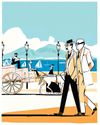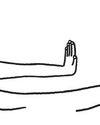
Handsome double-wide brick buildings line the Herengracht's banks, their corniced façades reflected on the water's surface. Interspersed among the new homes are spaces, like gaps in a young child's smile, where vacant lots have yet to be developed.
For the Dutch architect Koen Olthuis, the painting serves as a reminder that much of his country has been built on top of the water. The Netherlands (whose name means "low countries") lies in a delta where three major rivers-the Rhine, the Meuse, and the Scheldtmeet the open expanse of the North Sea.
More than a quarter of the country sits below sea level. Over hundreds of years, the Dutch have struggled to manage their sodden patchwork of land. Beginning in the fifteenth century, the country's windmills were used to pump water out of the ground using the hydraulic mechanism known as Archimedes' screw.
Parcels of land were buffered with raised walls and continuously drained, creating areas, which the Dutch call "polders," that were dry enough to accommodate farming or development. The grand townhouses along Amsterdam's canals, as emblematic of the city as Haussmann's architecture is of Paris, were constructed on thousands of wooden stilts driven into unstable mud. As Olthuis told me recently, "The Netherlands is a complete fake, artificial machine.
"The threat of water overtaking the land is so endemic to the Dutch national psyche that it has inspired a mythological predator, the Waterwolf. In a 1641 poem that coined the name, the Dutch poet and playwright Joost van den Vondel exhorted the "mill wings of the wind pumps to "shut down this animal."
This story is from the April 01, 2024 edition of The New Yorker.
Start your 7-day Magzter GOLD free trial to access thousands of curated premium stories, and 9,000+ magazines and newspapers.
Already a subscriber ? Sign In
This story is from the April 01, 2024 edition of The New Yorker.
Start your 7-day Magzter GOLD free trial to access thousands of curated premium stories, and 9,000+ magazines and newspapers.
Already a subscriber? Sign In

BADDIE ISSUES
\"Wicked\" and \"Gladiator II.\"

LET'S MAKE A DEAL
\"Death Becomes Her\" and \"Burnout Paradise.\"

ANTI HEROES
\"The Franchise,\" on HBO.

FELLOW-TRAVELLERS
The surprisingly sunny origins of the Frankfurt School.

NOW YOU SEE ME
John Singer Sargent's strange, slippery portraits of an art dealer's family.

PARIS FRIEND - SHUANG XUETAO
Xiaoguo had a terror of thirst, so he kept a glass of water on the table beside his hospital bed. As soon as it was empty, he asked me to refill it. I wanted to warn him that this was unhealthy - guzzling water all night long puts pressure on the kidneys, and pissing that much couldn't be good for his injury. He was tall, though, so I decided his insides could probably cope.

WILD SIDE
Is Lake Tahoe's bear boom getting out of hand?

GETTING A GRIP
Robots learn to use their hands.

WITHHOLDING SEX FROM MY WIFE
In the wake of [the] election, progressive women, who are outraged over Donald Trump's victory at the ballot box, have taken to social media with public, vengeful vows of chastity. - The Free Press.

DEADLINE EXTENSION
Old age, reborn.